
The Rocca di Fontanellato takes up a commanding position in the middle of the town. It's surrounded by a pea green moat, not doubt colored by all the birds perched in its ramparts.

The historic water source...

In the main square is the local Catholic Church, the
Chiesa parrocchiale di Santa Croce.

Below is a look at some of the other buildings that line the main square. On the left is another place of worship, the Oratorio di San Gaetano.

I snapped the picture below wondering if I was interpreting that correctly. Kathi and I were later to find out that horse meat was a traditional special occasion delicacy.

Narrow streets in Fontanellato...

I circled back to "In Villa" and wandered around the surrounding gardens. Although outside the castle walls, the property was historically tied to the Rocca di Fontanellato. Here's the back door to the hotel.

And the extensive grounds...

Walking paths criss-cross through the woods where this miniature of the Rocca can be found.
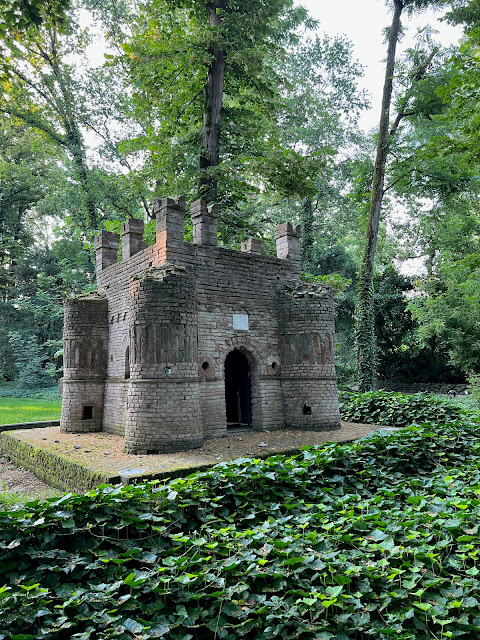
After my early morning spin, I returned to the hotel for a little snack before checking on Kathi.

All the fixings for a simple breakfast were laid out in preparation.

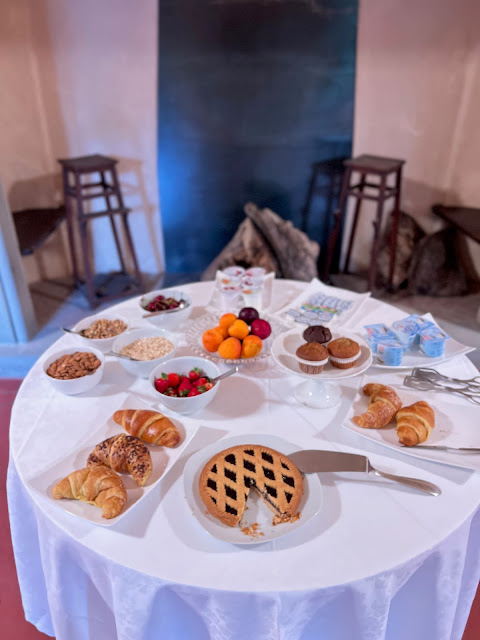
I had some yogurt and that space on my plate was formerly occupied by a croissant. Once Kathi joined me, breakfast was rounded out with a cappuccino, nutella, fruit and juice.
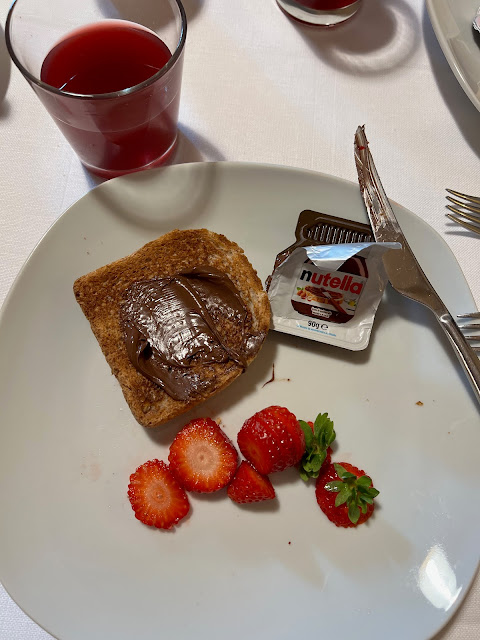
They would have made us eggs to order, but we passed on that. We didn't tarry too long because we had booked a tour of a parmigiano cheese-making farm. We drove in to Parma to meet our guide and parked in the train station parking garage. We were horrified to see broken glass in many of the parking spaces and one car with two windows seemingly recently bashed in. We wedged the Mercedes between a post and a wall as a means to thwart any would-be thieves and proceeded to the rendezvous point with much trepadation. We didn't leave any valuables, but all our clothes and stuff were in the covered trunk space.
We checked in with our guide and when we found that the farm was only about 15 miles from Parma, we asked if we could have the address, drive separately and meet them there. He said yes, so I raced back to the car and retrieved it before any damage was done. Kathi found the kiosk to pay and we were off to the Borgo del Gazzano farm.

We were first introduced to the farm and the cows - the stars of the show.
 Parmigiano Reggiano is a registered product and produced exclusively in the provinces of Parma, Reggio Emilia, Modena, Bologna to the left of the Reno river, and Mantua to the right of the Po river. Cows are fed a strict diet of locally grown plants without additives.
Parmigiano Reggiano is a registered product and produced exclusively in the provinces of Parma, Reggio Emilia, Modena, Bologna to the left of the Reno river, and Mantua to the right of the Po river. Cows are fed a strict diet of locally grown plants without additives.
 Next we went into the processing area where we learned about how milk is turned into cheese. The milk from the morning and the previous evening is poured into the traditional these copper kettles.
Next we went into the processing area where we learned about how milk is turned into cheese. The milk from the morning and the previous evening is poured into the traditional these copper kettles.

It takes about 550 liters of milk to produce each wheel of Parmigiano Reggiano. The milk slowly and naturally coagulates with the addition of rennet and a whey starter, from the previous day’s processing.
The curd which forms is then broken down by the master cheese-maker into minuscule granules using a traditional tool called “spino”. The ingredients are then cooked which makes the cheesy granules sink to the bottom of the cauldron forming a single mass.

After about fifty minutes the cheese-maker removes the cheese mass with a linen cloth and carefully cuts it into two portions.

We got to sample the curd before it was put into the molds, brined or aged. It reminded me of our friends the Nashes in Wisconsin and their love of cheese curds.

Yes, I got a hair net too!

Next, our guide showed us the plastic templates used to label the cheese wheels. The were made with holes that almost looked like brail; their impression would mark the cheese.

The divided cheese curds were placed in moulds which would be tightened and covered to give the wheels their final shape.

If I recall correctly, they're checked and tightened often so it is a time intensive process.
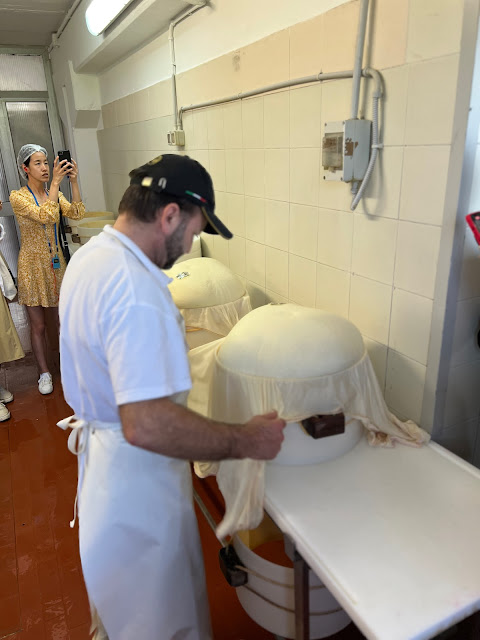

This is a one-day old wheel.

Next, the wheels are placed in a refrigerated room in a sea salt brine solution, using reverse osmosis (remember middle school science?) to draw out the water. The wheels float in the solution and have to be turned hourly to make sure the whole wheel is immersed to get the effect of the chemical reactions happening.

After a couple days in the brine, the wheels are stacked in a cool warehouse to age. The longer they age, the more valuable they become, but it's a delicate balance between storage costs and selling price. Each wheel has to be rotated daily and inspected for mold or any sign of imperfection to maintain top quality. Here's $1.5M euros worth of cheese.

You can't see it here, but yes, there are bars on all the windows, security cameras and the works to protect this investment. The labels on the wheel demonstrate the cheese's authenticity, the producer, batch, etc. The age stamp will be added later.

Periodically, the master cheese maker will test the quality of the cheese, by putting the wheel on this table and thumping it with a specialized hammer. He can tell by the sound if the cheese is uniform, developing well and aging appropriately.
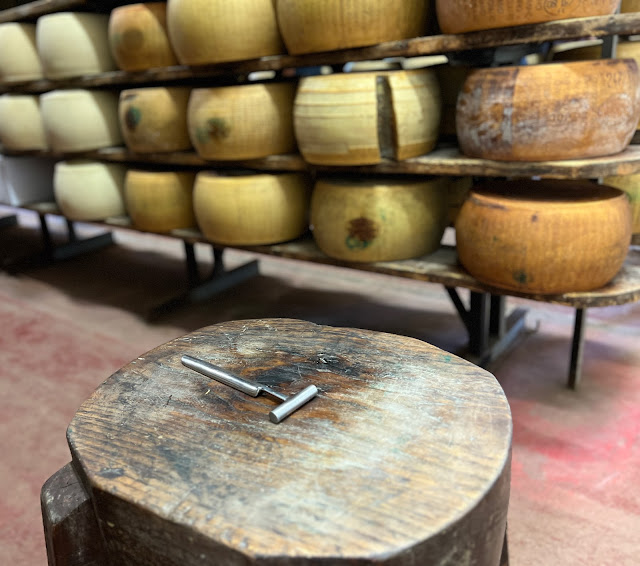

Finally were were able to taste-test! We were given 22 and 36 month-aged samples to taste the difference along with a trace of balsamic vinegar and a glass of wine to wash it all down.
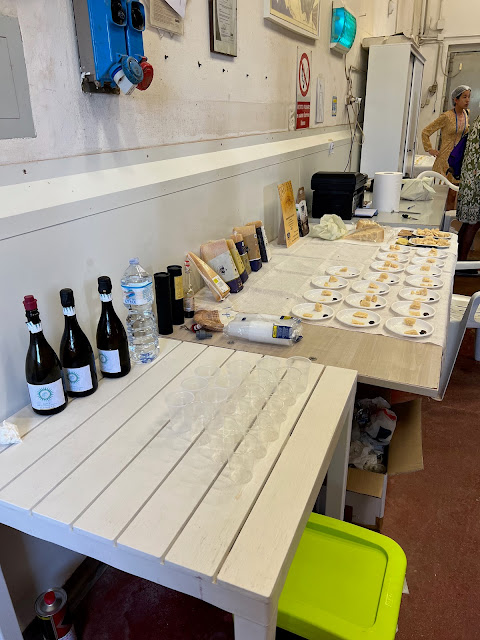

After the tour was over, Kathi wanted one more visit to feed the cows before we left. They were somewhat frightened by the Americano interloper.
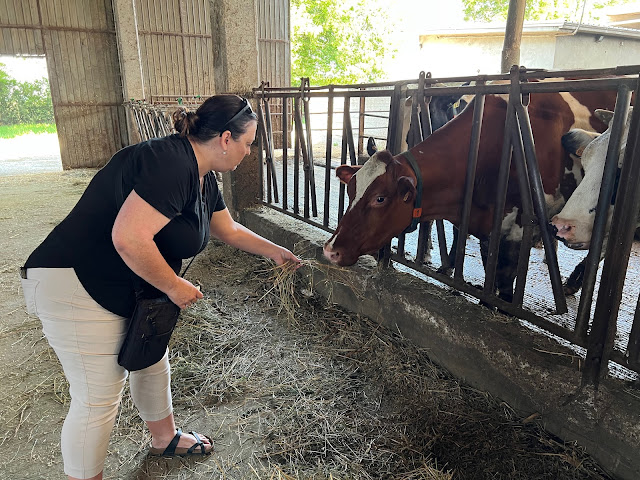

After my early morning spin, I returned to the hotel for a little snack before checking on Kathi.

All the fixings for a simple breakfast were laid out in preparation.


I had some yogurt and that space on my plate was formerly occupied by a croissant. Once Kathi joined me, breakfast was rounded out with a cappuccino, nutella, fruit and juice.

They would have made us eggs to order, but we passed on that. We didn't tarry too long because we had booked a tour of a parmigiano cheese-making farm. We drove in to Parma to meet our guide and parked in the train station parking garage. We were horrified to see broken glass in many of the parking spaces and one car with two windows seemingly recently bashed in. We wedged the Mercedes between a post and a wall as a means to thwart any would-be thieves and proceeded to the rendezvous point with much trepadation. We didn't leave any valuables, but all our clothes and stuff were in the covered trunk space.
We checked in with our guide and when we found that the farm was only about 15 miles from Parma, we asked if we could have the address, drive separately and meet them there. He said yes, so I raced back to the car and retrieved it before any damage was done. Kathi found the kiosk to pay and we were off to the Borgo del Gazzano farm.

We were first introduced to the farm and the cows - the stars of the show.
 Parmigiano Reggiano is a registered product and produced exclusively in the provinces of Parma, Reggio Emilia, Modena, Bologna to the left of the Reno river, and Mantua to the right of the Po river. Cows are fed a strict diet of locally grown plants without additives.
Parmigiano Reggiano is a registered product and produced exclusively in the provinces of Parma, Reggio Emilia, Modena, Bologna to the left of the Reno river, and Mantua to the right of the Po river. Cows are fed a strict diet of locally grown plants without additives. Next we went into the processing area where we learned about how milk is turned into cheese. The milk from the morning and the previous evening is poured into the traditional these copper kettles.
Next we went into the processing area where we learned about how milk is turned into cheese. The milk from the morning and the previous evening is poured into the traditional these copper kettles. 
It takes about 550 liters of milk to produce each wheel of Parmigiano Reggiano. The milk slowly and naturally coagulates with the addition of rennet and a whey starter, from the previous day’s processing.
The curd which forms is then broken down by the master cheese-maker into minuscule granules using a traditional tool called “spino”. The ingredients are then cooked which makes the cheesy granules sink to the bottom of the cauldron forming a single mass.

After about fifty minutes the cheese-maker removes the cheese mass with a linen cloth and carefully cuts it into two portions.

We got to sample the curd before it was put into the molds, brined or aged. It reminded me of our friends the Nashes in Wisconsin and their love of cheese curds.

Yes, I got a hair net too!

Next, our guide showed us the plastic templates used to label the cheese wheels. The were made with holes that almost looked like brail; their impression would mark the cheese.

The divided cheese curds were placed in moulds which would be tightened and covered to give the wheels their final shape.

If I recall correctly, they're checked and tightened often so it is a time intensive process.


This is a one-day old wheel.

Next, the wheels are placed in a refrigerated room in a sea salt brine solution, using reverse osmosis (remember middle school science?) to draw out the water. The wheels float in the solution and have to be turned hourly to make sure the whole wheel is immersed to get the effect of the chemical reactions happening.

After a couple days in the brine, the wheels are stacked in a cool warehouse to age. The longer they age, the more valuable they become, but it's a delicate balance between storage costs and selling price. Each wheel has to be rotated daily and inspected for mold or any sign of imperfection to maintain top quality. Here's $1.5M euros worth of cheese.

You can't see it here, but yes, there are bars on all the windows, security cameras and the works to protect this investment. The labels on the wheel demonstrate the cheese's authenticity, the producer, batch, etc. The age stamp will be added later.

Periodically, the master cheese maker will test the quality of the cheese, by putting the wheel on this table and thumping it with a specialized hammer. He can tell by the sound if the cheese is uniform, developing well and aging appropriately.


Finally were were able to taste-test! We were given 22 and 36 month-aged samples to taste the difference along with a trace of balsamic vinegar and a glass of wine to wash it all down.


After the tour was over, Kathi wanted one more visit to feed the cows before we left. They were somewhat frightened by the Americano interloper.

We bought some parmigiano reggiano of various ages (which we carried in our luggage for the rest or the trip!). Leaving the farm, we headed back into Parma for lunch and a looksee before heading to our final destination along Lago di Garda. We both couldn't get over all the poppies growing wild along the road. They're one of Kathi's favorite flowers.

Following in my father's footsteps, I also couldn't resist taking pictures of the fields full of wheat.
 After a short drive, we arrived in Parma and parked in a safe underground garage recommended by our farm guide. Our first stop was in the center of town - the Piazzale della Pace (the "Square of Peace"). Looking in from the Viale Giovanni Mariotti.
After a short drive, we arrived in Parma and parked in a safe underground garage recommended by our farm guide. Our first stop was in the center of town - the Piazzale della Pace (the "Square of Peace"). Looking in from the Viale Giovanni Mariotti.

With its large lawn, shallow pools, and trees, it seemed to be a popular spot to lounge, read, and meet with friends.

 Inside the Pizzale there's a monument to Giuseppe Verdi - a fragment of the alter once standing in front of the railway station but damaged by bombs during the second World War. It depicts scenes from his famous operas and episodes from the life of the maestro.
Inside the Pizzale there's a monument to Giuseppe Verdi - a fragment of the alter once standing in front of the railway station but damaged by bombs during the second World War. It depicts scenes from his famous operas and episodes from the life of the maestro.

Towards the back of the Pizzale, here's a look down the Strada Macedonio Melloni and the tower associated with the Il Castello dei Burattini
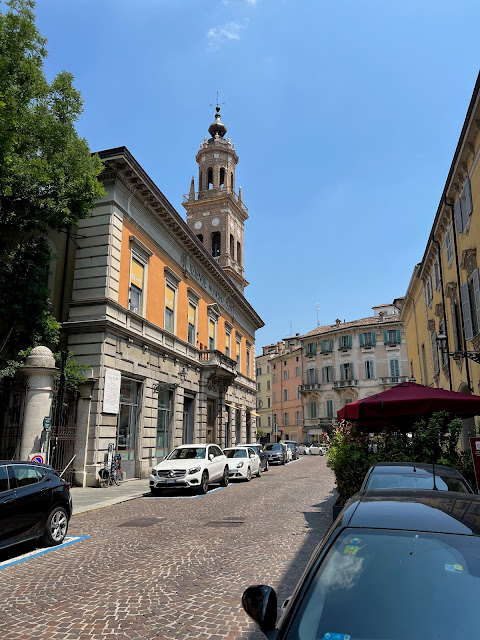
We were starting to get hungry and found a place recommended for lunch, but had to wait a bit for it to open. There was an open air bazaar selling used clothes and all sorts of things in the small square so we occupied ourselves window shopping until we could get a table at the recommended Osteria dei Servi. We both got traditional pasta to honor the St. John the Baptist feast day, tortelli d'erbetta with butter sage and 30 month parmesan cheese.

Mine was green tortelli with cooked San Secondo pork shoulder.

We only scratched the surface of Parma. It's probably worth a full day's exploring this large city but we were anxious make our way to Lago di Garda with enough time to enjoy our private terrace overlooking the lake. Walking back to the car we passed the Monumento Alla Vittoria dedicated to Italian victory in war.

We made our way out of Parma and steered the car towards Sant'Ambrogio di Valpolicella to get a work colleague's recommended bottle of Amarone I was thinking we might get a couple since it came so highly recommended, but upon arriving at the family winery we found three bottles of varying price based on age. The cheapest, the Amarone Della Valpolicella "classico", was $35 euros - kind of rich for our unsophisticated palettes, so we just bought one.

Mission accomplished, we headed west to Lago di Garda and then drove along the lake until we made it to the town of Garda and our hotel Lat Vittoria. We caused a little bit of a stir in a pedestrian zone, trying to figure out where to park, but Kathi got the intel from the hotel desk and we found a parking lot nearby to stow the car.
The hotel was in a great location at the end of a series of hotels overlooking the harbor.
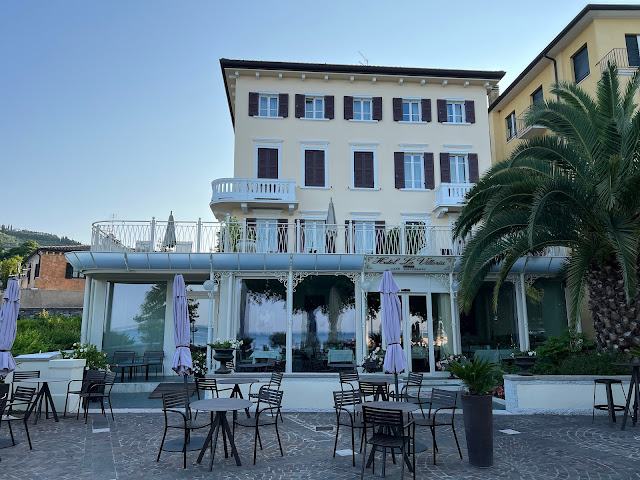 And the private terrace was glorious!
And the private terrace was glorious!
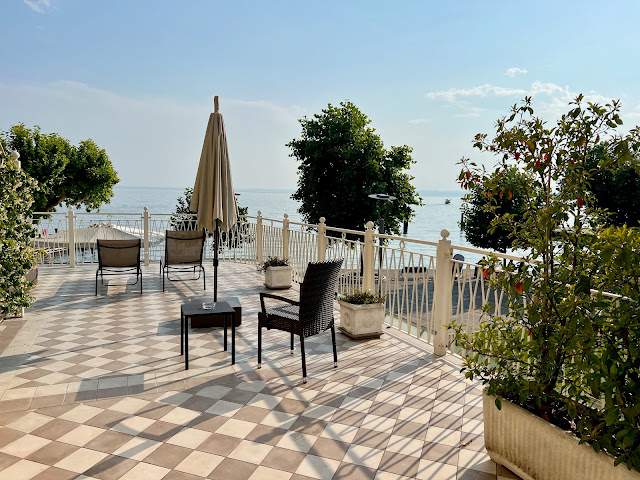


After getting settled and a quick shower, we went for a walkabout. The shoreline promenade was lined with restaurants and tables along the lakefront.



Following in my father's footsteps, I also couldn't resist taking pictures of the fields full of wheat.
 After a short drive, we arrived in Parma and parked in a safe underground garage recommended by our farm guide. Our first stop was in the center of town - the Piazzale della Pace (the "Square of Peace"). Looking in from the Viale Giovanni Mariotti.
After a short drive, we arrived in Parma and parked in a safe underground garage recommended by our farm guide. Our first stop was in the center of town - the Piazzale della Pace (the "Square of Peace"). Looking in from the Viale Giovanni Mariotti.
With its large lawn, shallow pools, and trees, it seemed to be a popular spot to lounge, read, and meet with friends.

 Inside the Pizzale there's a monument to Giuseppe Verdi - a fragment of the alter once standing in front of the railway station but damaged by bombs during the second World War. It depicts scenes from his famous operas and episodes from the life of the maestro.
Inside the Pizzale there's a monument to Giuseppe Verdi - a fragment of the alter once standing in front of the railway station but damaged by bombs during the second World War. It depicts scenes from his famous operas and episodes from the life of the maestro.
Towards the back of the Pizzale, here's a look down the Strada Macedonio Melloni and the tower associated with the Il Castello dei Burattini

We were starting to get hungry and found a place recommended for lunch, but had to wait a bit for it to open. There was an open air bazaar selling used clothes and all sorts of things in the small square so we occupied ourselves window shopping until we could get a table at the recommended Osteria dei Servi. We both got traditional pasta to honor the St. John the Baptist feast day, tortelli d'erbetta with butter sage and 30 month parmesan cheese.

Mine was green tortelli with cooked San Secondo pork shoulder.

We only scratched the surface of Parma. It's probably worth a full day's exploring this large city but we were anxious make our way to Lago di Garda with enough time to enjoy our private terrace overlooking the lake. Walking back to the car we passed the Monumento Alla Vittoria dedicated to Italian victory in war.

We made our way out of Parma and steered the car towards Sant'Ambrogio di Valpolicella to get a work colleague's recommended bottle of Amarone I was thinking we might get a couple since it came so highly recommended, but upon arriving at the family winery we found three bottles of varying price based on age. The cheapest, the Amarone Della Valpolicella "classico", was $35 euros - kind of rich for our unsophisticated palettes, so we just bought one.

Mission accomplished, we headed west to Lago di Garda and then drove along the lake until we made it to the town of Garda and our hotel Lat Vittoria. We caused a little bit of a stir in a pedestrian zone, trying to figure out where to park, but Kathi got the intel from the hotel desk and we found a parking lot nearby to stow the car.
The hotel was in a great location at the end of a series of hotels overlooking the harbor.
 And the private terrace was glorious!
And the private terrace was glorious!


After getting settled and a quick shower, we went for a walkabout. The shoreline promenade was lined with restaurants and tables along the lakefront.


We stopped at a small park, Punta Panoramico, near where the mountain streams discharge into the lake. From there we got a great view of the impressive geologic formation, La Rocca.

Next time, we will have to drive up there for a view down upon the town and the coastline.

We returned along the shoreline, back to our hotel, to snag a waterfront table for dinner.
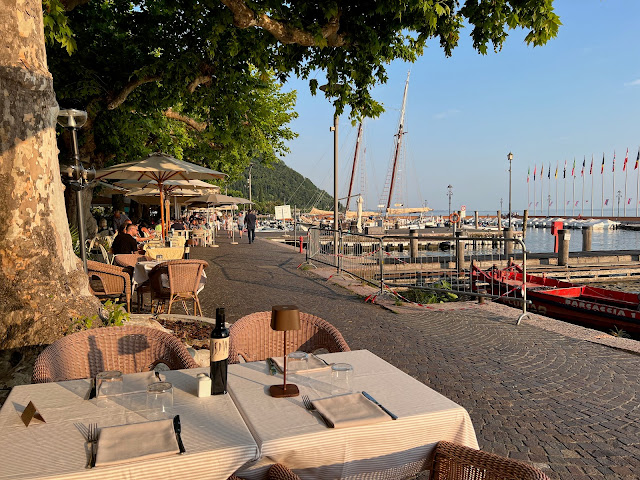
I had trofie with pesto - delicious!

Just as we were finishing dinner a storm started to roll in, so we rushed across the promenade into our hotel and secured the furniture on the terrace. After the storm passed, we reconvened on the terrace to enjoy the Amarone as evening fell and the street lights came to life.

Next time, we will have to drive up there for a view down upon the town and the coastline.

We returned along the shoreline, back to our hotel, to snag a waterfront table for dinner.

I had trofie with pesto - delicious!

Just as we were finishing dinner a storm started to roll in, so we rushed across the promenade into our hotel and secured the furniture on the terrace. After the storm passed, we reconvened on the terrace to enjoy the Amarone as evening fell and the street lights came to life.

No comments:
Post a Comment